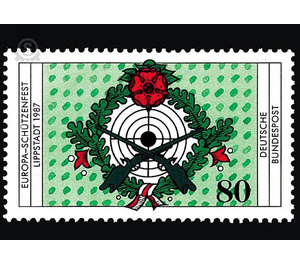Europe-Schutzfest Lippstadt - Germany / Federal Republic of Germany 1987 - 80 Pfennig
Theme: Post & Philately
| Country | Germany / Federal Republic of Germany |
| Issue Date | 1987 |
| Face Value | 80.00 |
| Color | green |
| Perforation | K 14:14 1/4 |
| Printing Type | 4-color offset printing |
| Stamp Type | Postage stamp |
| Item Type | Stamp |
| Chronological Issue Number | 1203 |
| Chronological Chapter | GER-BRD |
| Michel ID | BRD 1330 |
| SID | 793697 |
| In 42 Wishlists | |
Sagittarius in Europe is a cultural-historical phenomenon which, despite some minor changes, has not only preserved its original character from the Crusades to the present for centuries, but also has no equal in the multitude of similar associations in town and country. The commonality is based on customs, which, although between the north and south of Europe larger, within these areas but only slightly different. Shooting exercises - initially with the crossbow or with bow and arrow, in places even today maintained, and later with the rifle -, the consistently annual rifle festival with the coronation of the king, who achieves his dignity mostly in the firing of a wooden bird (originally a parrot) and the procession through city or town in colorful costume, characterize this tradition. It has become so popular among the population that the shooting festivals are true folk festivals. Despite the commonality of this tradition, there was never a regional merger in former times. Well known in the 15th and 16th centuries so-called free shooting, z. Such as those in Vienna, Augsburg, Strasbourg, Cologne and elsewhere, to which shooters from near and far flocked, so that these festivals can be described as tournaments of the bourgeoisie at that time. A first union of rifle companies on German soil took place in 1861, when the German Schützenbund was formed on the occasion of a general shooting festival in Gotha, which today largely takes on the sport shooting. Regional associations, which are mainly dedicated to traditional care, have emerged only recently, u. a. as one of the first in 1928 the "Bund der Historischen Deutschen Schützenbruderschaften". In the western neighboring countries they are even younger; in other countries they have only recently emerged or are emerging. The attempt to clarify the common ground across national borders was first made in 1955, when three Dutchmen and one Belgian founded a foundation to promote rifle use in Western European countries. An international federation-like merger was only undertaken in 1962 in Eilendorf near Aachen with the participation of German, Belgian and Dutch archers. It still exists today as an "international rifle community in the tri-border region", although it did not go beyond these border areas. Therefore, new considerations, dating back to 1970, under the current name of the European Community of Historical Riflemen in 1975 led to a re-establishment with the aim of fraternizing the international solidarity of the shooters and their customs, tradition and spirit 1955, with elements of the 1955 foundation charter incorporated into the new statutes. Visible signs of this attachment were until now the European shooting festivals, usually at intervals of two years: 1975 in Aachen, 1977 in Nijmegen, 1979 in Peer, 1981 in Koblenz, 1982 in Eindhoven and 1985 in Eupen. If shooters from Germany, Belgium and the Netherlands arrived at the first festivities, shooters from France, Austria, South Tyrol, San Marino, England and Sweden gradually joined. The meeting of shooters from many countries on 12 and 13 September 1987 in Lippstadt should contribute to national diversity to a fraternally united Europe, in which, according to the protector of the European rifle community, Dr. med. Otto von Habsburg, "there are people who, especially at a time when traditions are destroyed, are part of their tradition." In the host city of Lippstadt in East Westphalia, riflemen have a tradition dating back to the Middle Ages. At least since the middle of the 15th century, demonstrably since 1532, Lippstadt citizens were united in a rifle brotherhood. In the city of Lippstadt and in its 17 districts, the Schützenbrauchtum is now maintained in numerous, partly founded in the 19th century shooting clubs. (Text: Dr. Theo Reintges, Confederation of the European Community Historical shooter, Dr. Hartwig Walberg, City Upperarchivrat, City Archives Lippstadt)
| Condition | Name | In Stock | Price | Price + Shipping | Store | |
|---|---|---|---|---|---|---|
 | Unmounted Mint ** | Europe-Schutzfest Lippstadt - Germany / Federal Republic of Germany 1987 - 80 Pfennig | 10 | US $0.861 | US $4.08 |  FILATELIELOKET (0) FILATELIELOKET (0)Shipping US $3.22 Minimum Order US $2.69 |


